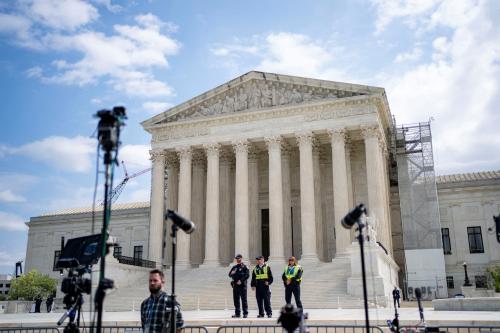This blog was updated on June 14, 2024.
Ever since the 118th Congress convened in January of 2023, it has been held hostage by approximately 100 Republicans whose tactics have consistently thwarted or tried to thwart the will of the majority. Finally, on April 20, in a Saturday session, the Speaker brought several votes to the floor under a rule that passed 316-94. Aid to Israel passed with 366 votes, aid to Ukraine passed with 311 votes, aid to Taiwan with 385 votes, and the TikTok ban with 360 votes. Each vote was slightly different, with some progressive Democrats voting against Israel aid and some hard right Republicans voting against Ukraine aid. But the overall success of the strategy created a new coalition and sidelined the hard right Republicans—at least for the moment. So, what happens next? In the short-term, Representative Marjorie Taylor Green (R-Ga.) is threatening to oust Speaker Mike Johnson (R-La.). But this time around, it is likely that Democrats will vote for Johnson and thus keep him in the speaker’s seat at least until the next election. In the longer term, the question is, Will we look back on the April 20 vote as the beginning of a return to a more normal Republican Party? “Normies” as they are known at The Bulwark—home base for Never Trump Republicans—is a reference to Republicans who worry about taxes and regulation and who support the military and America’s leadership role in the world. My colleague Jonathan Rauch and Pete Wehner have written about this group as the “Republican Party in exile.” But how many are there, and how likely are they to regain control of the Republican Party from the MAGA right wing? In an attempt to answer this question, this piece looks at three sets of numbers—the Nikki Haley primary voters, the anti-Ukraine Republicans, and the Republican congressional candidates.
The Haley voters
Although Nikki Haley did not manage to win a major state (her only wins were Vermont and the District of Columbia), she became the focus for anti-Trump sentiment in the Republican primaries and continued to win votes even after she formally dropped out of the race on March 6. In the primaries (as of this writing), Haley got between 5.4% and 43.2% of the vote. But it’s hard to say what the Haley vote means. In some states where she did well, such as New Hampshire, Democrats were allowed to vote in the Republican primary, and they will most likely return to Biden in the fall. Some of her voters will end up “coming home” to the Republican Party and voting for Trump in the fall, and others may be tempted by a third party candidate. Nonetheless, her ability to be the last one standing does give us a rough estimate of the size and potential significance of the Haley vote in the Republican Party. For instance, in the North Carolina Republican primary (March 5) Haley got 250,838 votes—in 2020, Trump won the state by only 74,483 votes. In the Arizona Republican primary (March 19), she got 110,948 votes. In 2020, Biden won the state by a mere 10,457 votes. In the Super Tuesday primaries, Haley averaged 26% of the vote. In primaries to date following Super Tuesday, she still averaged 15% of the vote even though she had dropped out of the race. A Quinnipiac poll found that half of Haley voters would vote for Trump but that 37% would vote for Biden. In Virginia, an exit poll found that on the critical question “In the election for president this November, will you vote for the Republican nominee regardless of who it is?” 31% of Virginia voters said no and 76% of the no votes were Haley voters. Sensing a group of persuadables, the Biden campaign and Biden himself have reached out to Haley voters.
The Ukraine vote
Another way to look at the size of a possible “normal” Republican Party is to look at the House vote on aid to Ukraine. In that vote, more House Republicans voted against aid to Ukraine (112) than voted in favor (102). Most of the Republicans voting against Ukraine aid came from heavily Republican districts where the average Cook PVI was 14.7%. However, in a similar vote in May of 2022, only 57 Republicans voted against aid to Ukraine. What happened between May of 2022 and April of 2024? Donald Trump weighed in—arguing that aid was not in America’s vital interests and killing a bill that contained a compromise border bill along with the Ukraine aid. Speaker Johnson immediately fell in line and caused a long and potentially damaging delay in aid to Ukraine before he changed his mind.
The 2024 Republican primary congressional candidates
At Brookings, we are studying every single candidate running for the nomination of their party in 2024. We look at their websites, their social media, their votes (if incumbents), and their media interviews to determine what kind of Republican they are. The table below shows the results for five primaries that have taken place so far in very Republican states (R+5 or greater according to the Cook Political Report). In very Republican Alabama and Mississippi, we identified at least 50% of the Republican congressional candidates as MAGA and or Trump conservatives. In Arkansas, there were very few candidates, so we probably can’t draw too many conclusions. In the two big states in this mix, Ohio and Texas, there were plenty of MAGA/Trump candidates—they won 32% of their races in Ohio and 55% in Texas. In these very Republican states, there were practically no Republican moderates running in the primaries. Leaving out Arkansas (for the reason noted above), about 20% to 50% of the candidates were more conventional Republicans—“normies,” if you will. It shows, as we’ve seen in these studies before, that while the Republican Party has certainly been remade by Trump—there is still a group of Republicans who hold Trump at arm’s length and manage to win elections.
Is there a normal Republican Party in our future?
The answer depends on whether you are someone who sees the glass as half empty or half full. Take, for instance, the Haley vote. She started out with a substantial chunk of the vote in New Hampshire and acquitted herself well in those early states, leading the optimists to believe she could unite non-Trump Republicans. But her failure to win a major state or a substantial number of delegates stopped her momentum. What Haley has going for her is that she is young, only 52 years old, as is another non-Trump Republican leader, former Representative Liz Cheney—57 years old. They, along with former Vice President Mike Pence (64 years old), who has refused to endorse Trump (as has Haley as of this writing), have a small core of voters, probably around 20% of the Republican electorate, from which they can grow a more normal Republican Party in the future. The picture in the Congress is not very encouraging. In just two years the number of Republican incumbents falling in line behind Trump on the critical issue of aid to Ukraine has practically doubled. Given that districts in the House of Representatives are more homogeneous by party than they’ve ever been in American history, incumbents need not worry about the general election, but they do worry about strong challenges in the primary. This makes incumbent House members even more reluctant to oppose Trump. Finally, in looking at the Republicans in five states who have chosen to run for Congress in 2024, we find large numbers running as MAGA conservatives and winning. Nonetheless, a substantial number of Republican candidates stay away from MAGA and Trump and pursue what look like more moderate campaigns. They won 35% of their races in Texas and 67% in Mississippi. So, what do we know so far? There are “normies” out there, but their numbers are not big. Depending on the measure used, between about 20% and 40% of the party is at least somewhat uncomfortable with MAGA and Trump—though the percentage who actively oppose Trump and will stay home or vote for Biden in November is probably much smaller. If you are a glass half full person you conclude that this is a decent base from which to reconstruct a post-Trump party. If you are a glass half empty person you are resigned to a political party shaped by Trump whether he is around or not. Either could be right.
-
Acknowledgements and disclosures
Special thanks to Jordan Muchnick, Dierdre Keenan and Elizabeth Smith who work on the congressional primaries project.
The Brookings Institution is committed to quality, independence, and impact.
We are supported by a diverse array of funders. In line with our values and policies, each Brookings publication represents the sole views of its author(s).









Commentary
Will the Republican Party return to normal?
May 1, 2024